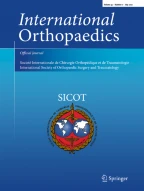Abstract
Background
The EOS™ X-ray machine, based on a Nobel prize-winning invention in physics in the field of particle detection, is capable of a simultaneous capture of biplanar X-ray images by slot scanning of the whole body in an upright, physiological load-bearing position, using ultra-low radiation doses. The simultaneous capture of spatially calibrated anterioposterior and lateral images provides a three-dimensional (3D) surface reconstruction of the skeletal system using a special software. Parts of the skeletal system in X-ray images and 3D-reconstructed models appear in true 1:1 scale for size and volume, thus spinal and vertebral parameters, lower limb axis lengths and angles, as well as any relevant clinical parameters in orthopaedic practice can be very precisely measured and calculated. Visualisation of 3D reconstructed models in various views by sterEOS 3D software enables presentation of top view images to help analyse rotational conditions of lower limbs, joints and spine deformities in the horizontal plane, providing revolutionary novel possibilities in orthopaedic surgery, especially in spine surgery.
Approach and conclusions
Our department has been extensively using the very first commercially available EOS™ imaging system worldwide for routine orthopaedic diagnostics since June 2007. During this period of about 4.5 years, more than 5,700 standard examinations have been carried out, about a third of them in spine deformity cases and the rest in lower limb orthopaedic cases. In this mini-review, general principles and uses of this groundbreaking integrated orthopaedic solution is reviewed with a few highlighted examples from our own clinical practice.
Similar content being viewed by others
References
The Nobel Prize in Physics (1992) Nobelprize.org. The official web site of the Nobel Prize. http://nobelprize.org/nobel_prizes/physics/laureates/1992/index.html. Accessed December 19, 2011
Charpak G (1981) La détection des particules. Recherche 128:1384–1396
Charpak G (1993) Electronic imaging of ionizing radiation with limited avalanches in gases. Rev Mod Phys 6:591–598
Després P, Beaudoin G, Gravel P et al (2005) Evaluation of a full-scale gas microstrip detector for low-dose X-ray imaging. Nucl Instr Meth Phys Res A 536:52–60
Dubousset J, Charpak G, Dorion I et al (2005) Le system EOS nouvelle imagerie osteo-articulaire basse dose en position debout. E-mémoire de l’Académie National de Chirugie 4:22–27
Dubousset J, Charpak G, Dorion I et al (2005) A new 2D and 3D imaging approach to musculoskeletal physiology and pathology with low-dose radiation and the standing position: the EOS system. Bull Acad Natl Med 189:287–297
Le Bras A, Laporte S, Mitton D et al (2002) 3D detailed reconstruction of vertebrae with low dose digital stereoradiography. Stud Health Technol Inform 91:286–290
Le Bras A, Laporte S, Mitton D et al (2003) A biplanar reconstruction method based on 2D and 3D contours: application to the distal femur. Comput Methods Biomech Biomed Engin 6:1–6
Mitton D, Landry C, Véron S et al (2000) A 3D reconstruction method from biplanar radiography using non-stereocorresponding points and elastic deformable meshes. Med Biol Eng Comput 38:133–139
Mitulescu A, Semaan I, De Guise JA et al (2001) Validation of the non-stereo corresponding points stereoradiographic 3D reconstruction technique. Med Biol Eng Comput 39:152–158
Kalifa G, Charpak G, Maccia C et al (1998) Evaluation of a new low-dose digital x-ray device: first dosimetric and clinical result in children. Pediatr Radiol 28:557–561
Than P, Szuper K, Somoskeöy S et al (2011) Geometrical values of the normal and arthritic hip and knee detected with the EOS imaging system. Int Orthop (SICOT). doi:10.1007/s00264-011-1403-7
Conflict of interest
The authors declare that they have no conflict of interest.
Author information
Authors and Affiliations
Corresponding author
Rights and permissions
About this article
Cite this article
Illés, T., Somoskeöy, S. The EOS™ imaging system and its uses in daily orthopaedic practice. International Orthopaedics (SICOT) 36, 1325–1331 (2012). https://doi.org/10.1007/s00264-012-1512-y
Received:
Accepted:
Published:
Issue Date:
DOI: https://doi.org/10.1007/s00264-012-1512-y
